HRD Report: Learning Styles, Training, Development and Evaluation
VerifiedAdded on 2020/06/04
|21
|5738
|23
Report
AI Summary
This report provides a detailed analysis of Human Resource Development (HRD), focusing on learning styles, training, and development programs. It begins by exploring various learning styles, including Kolb's model, and examines the function of the learning curve in skill development. The report then delves into the contributions of learning theories in organizing learning events, followed by an examination of the role of government in learning and development initiatives. The impact of competency development on both the private and public sectors is assessed, along with a review of contemporary training programs. The report further addresses training needs at different hierarchical levels, explores the advantages and disadvantages of different training techniques, and outlines a systematic approach to training and development events. Finally, it presents an evaluation plan for training events, discusses methods for evaluating these events, and assesses the success of different evaluation approaches, culminating in a comprehensive conclusion and references.
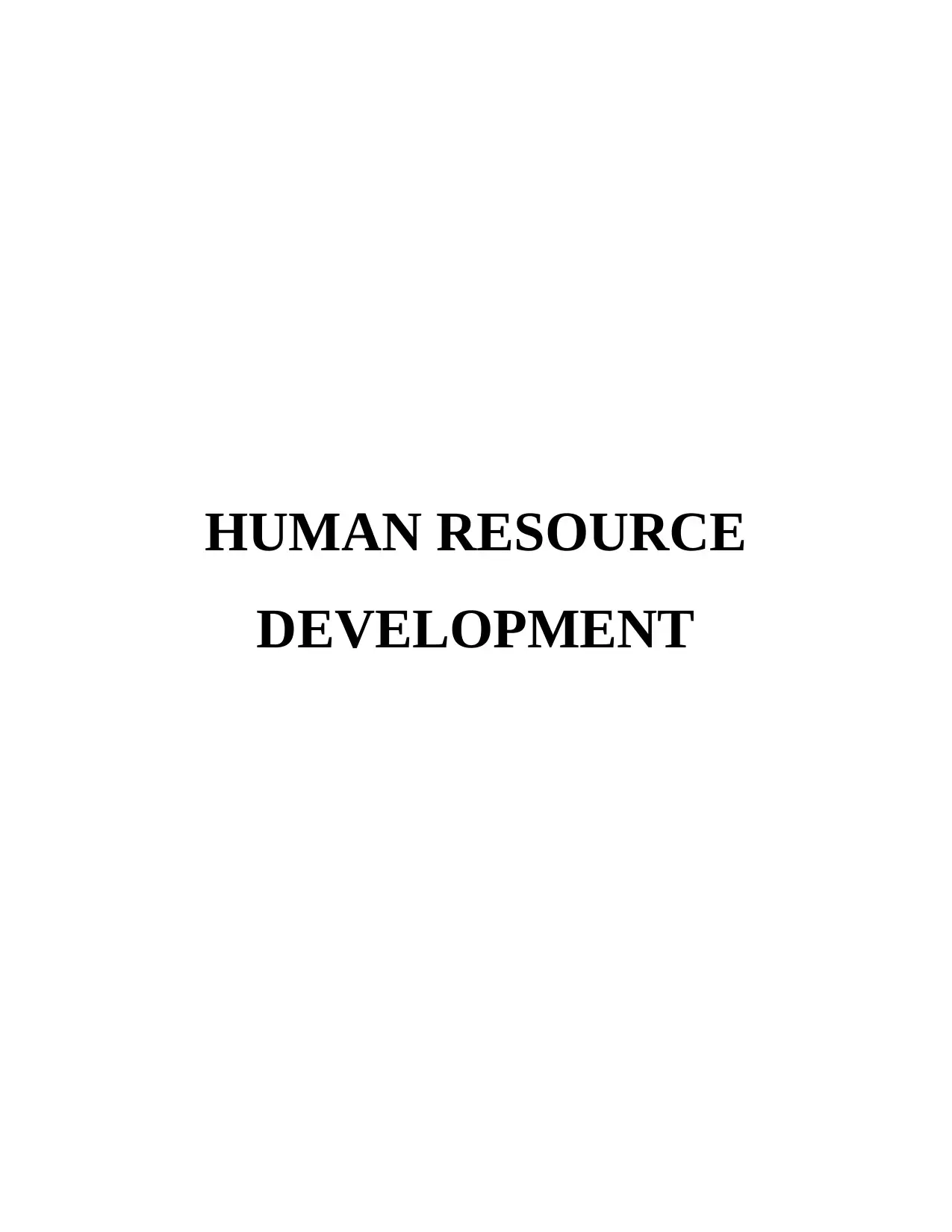
HUMAN RESOURCE
DEVELOPMENT
DEVELOPMENT
Paraphrase This Document
Need a fresh take? Get an instant paraphrase of this document with our AI Paraphraser
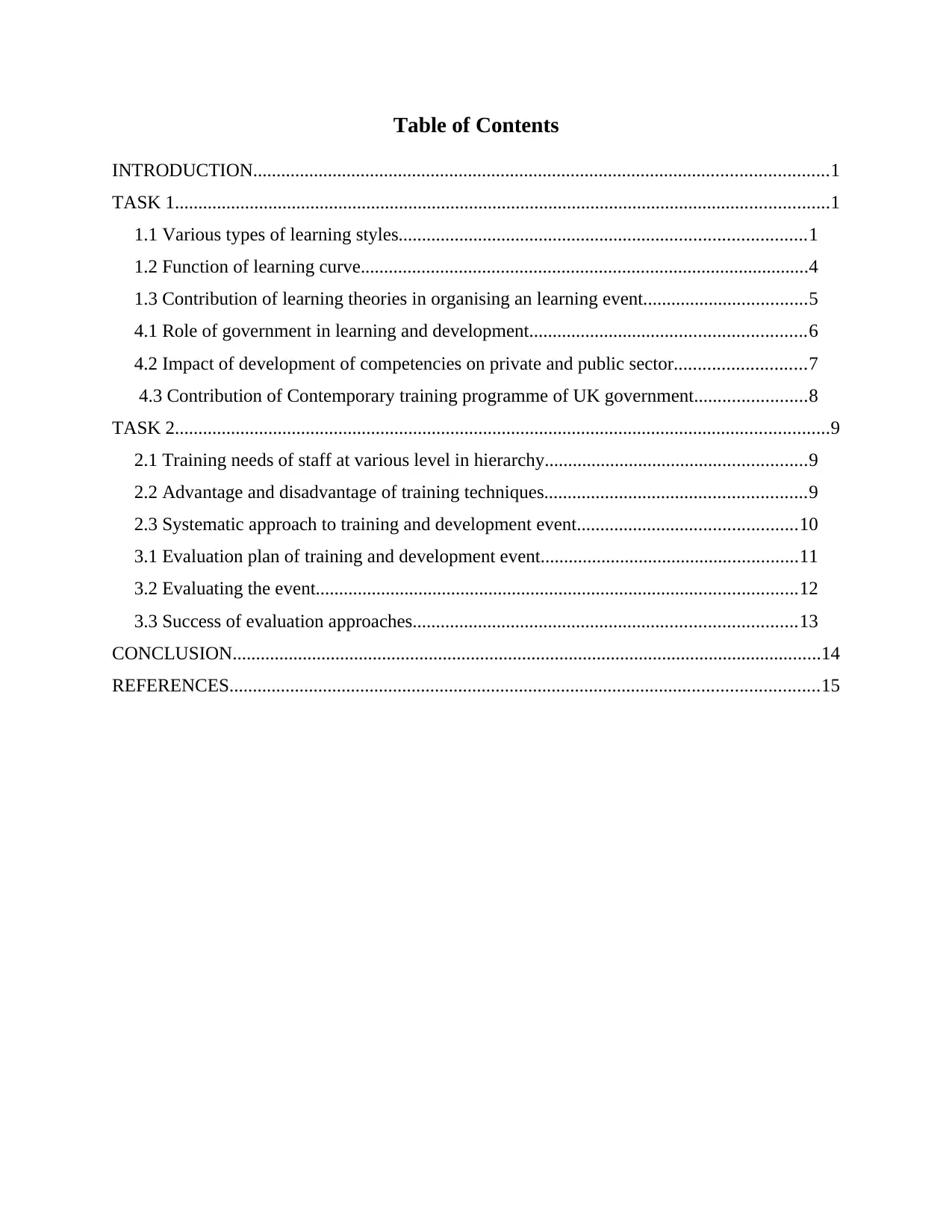
Table of Contents
INTRODUCTION...........................................................................................................................1
TASK 1............................................................................................................................................1
1.1 Various types of learning styles.......................................................................................1
1.2 Function of learning curve................................................................................................4
1.3 Contribution of learning theories in organising an learning event...................................5
4.1 Role of government in learning and development...........................................................6
4.2 Impact of development of competencies on private and public sector............................7
4.3 Contribution of Contemporary training programme of UK government........................8
TASK 2............................................................................................................................................9
2.1 Training needs of staff at various level in hierarchy........................................................9
2.2 Advantage and disadvantage of training techniques........................................................9
2.3 Systematic approach to training and development event...............................................10
3.1 Evaluation plan of training and development event.......................................................11
3.2 Evaluating the event.......................................................................................................12
3.3 Success of evaluation approaches..................................................................................13
CONCLUSION..............................................................................................................................14
REFERENCES..............................................................................................................................15
INTRODUCTION...........................................................................................................................1
TASK 1............................................................................................................................................1
1.1 Various types of learning styles.......................................................................................1
1.2 Function of learning curve................................................................................................4
1.3 Contribution of learning theories in organising an learning event...................................5
4.1 Role of government in learning and development...........................................................6
4.2 Impact of development of competencies on private and public sector............................7
4.3 Contribution of Contemporary training programme of UK government........................8
TASK 2............................................................................................................................................9
2.1 Training needs of staff at various level in hierarchy........................................................9
2.2 Advantage and disadvantage of training techniques........................................................9
2.3 Systematic approach to training and development event...............................................10
3.1 Evaluation plan of training and development event.......................................................11
3.2 Evaluating the event.......................................................................................................12
3.3 Success of evaluation approaches..................................................................................13
CONCLUSION..............................................................................................................................14
REFERENCES..............................................................................................................................15

⊘ This is a preview!⊘
Do you want full access?
Subscribe today to unlock all pages.

Trusted by 1+ million students worldwide

INTRODUCTION
Human resource development programme helps in developing new skills and capabilities
in individual to increase efficiency of employee while working in organisation. Different
companies are engaged in developing newer competencies according to changing external
environmental factors. The human being are the most flexible asset for any organisation which
can be moulded according to changing requirements of firm through training and development.
Learning outcomes from the training should be practised by employee during working in
organisation in order to enhance the performance level of employee in many folds (Ayyagari,
Grover and Purvis, 2011).
The companies are engaged in organising various events related to learning and
development of workforce through continuous mentoring, coaching, succession planning and
career development plans. All these activities brings new competencies in behaviour of
individual. Development is an long term process that includes overall development of previously
of individual. Government policies largely motivates the companies to organise various training
and development plans to enhance profitability of firm and provides higher satisfaction to
workforce.
In this particular report the various learning styles that are followed by the participants of
training and development plan are accessed. This helps increasing success rate of training
programme that ultimately contributes in increased profit of firms. This report also studies about
various theories that can helps in increasing the rate of gaining experience by employee in
workplace.
TASK 1
1.1 Various types of learning styles.
The various learning styles depends on the experience of an individual and capabilities to
implement new concept development through interpreting gained experience. Kolbs model
defines various aspects that affects an individual learning style. This model is based on the
Concrete experience, Reflective observation which is flowed by Abstract conceptualisation and
Active experimentation. This is an cycle which helps in in develop new capabilities in workforce
through following various learning styles in practice (Barnett and Morse, 2013). Learning style
can be described as the services of actions or activities that helping in developing new
1
Human resource development programme helps in developing new skills and capabilities
in individual to increase efficiency of employee while working in organisation. Different
companies are engaged in developing newer competencies according to changing external
environmental factors. The human being are the most flexible asset for any organisation which
can be moulded according to changing requirements of firm through training and development.
Learning outcomes from the training should be practised by employee during working in
organisation in order to enhance the performance level of employee in many folds (Ayyagari,
Grover and Purvis, 2011).
The companies are engaged in organising various events related to learning and
development of workforce through continuous mentoring, coaching, succession planning and
career development plans. All these activities brings new competencies in behaviour of
individual. Development is an long term process that includes overall development of previously
of individual. Government policies largely motivates the companies to organise various training
and development plans to enhance profitability of firm and provides higher satisfaction to
workforce.
In this particular report the various learning styles that are followed by the participants of
training and development plan are accessed. This helps increasing success rate of training
programme that ultimately contributes in increased profit of firms. This report also studies about
various theories that can helps in increasing the rate of gaining experience by employee in
workplace.
TASK 1
1.1 Various types of learning styles.
The various learning styles depends on the experience of an individual and capabilities to
implement new concept development through interpreting gained experience. Kolbs model
defines various aspects that affects an individual learning style. This model is based on the
Concrete experience, Reflective observation which is flowed by Abstract conceptualisation and
Active experimentation. This is an cycle which helps in in develop new capabilities in workforce
through following various learning styles in practice (Barnett and Morse, 2013). Learning style
can be described as the services of actions or activities that helping in developing new
1
Paraphrase This Document
Need a fresh take? Get an instant paraphrase of this document with our AI Paraphraser
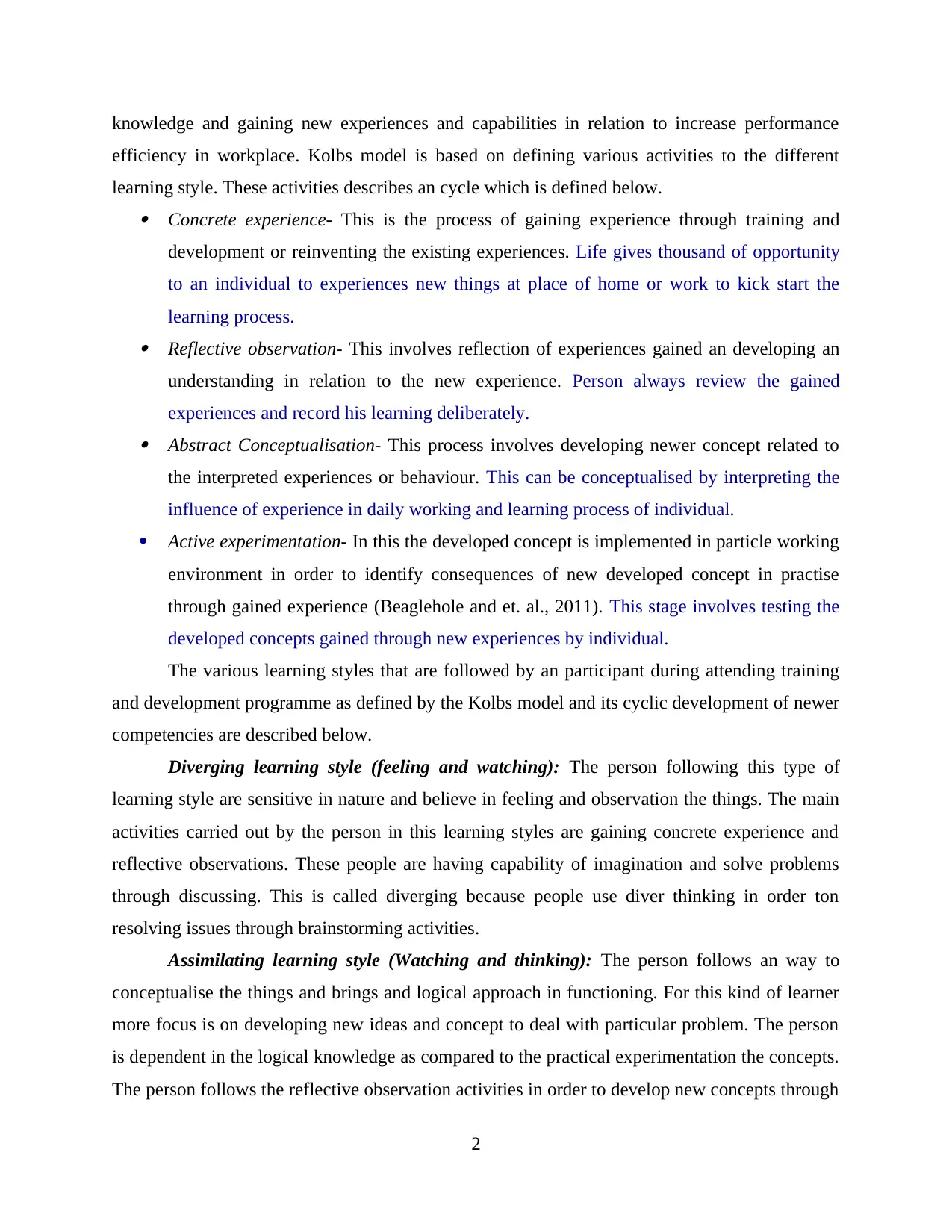
knowledge and gaining new experiences and capabilities in relation to increase performance
efficiency in workplace. Kolbs model is based on defining various activities to the different
learning style. These activities describes an cycle which is defined below. Concrete experience- This is the process of gaining experience through training and
development or reinventing the existing experiences. Life gives thousand of opportunity
to an individual to experiences new things at place of home or work to kick start the
learning process. Reflective observation- This involves reflection of experiences gained an developing an
understanding in relation to the new experience. Person always review the gained
experiences and record his learning deliberately. Abstract Conceptualisation- This process involves developing newer concept related to
the interpreted experiences or behaviour. This can be conceptualised by interpreting the
influence of experience in daily working and learning process of individual.
Active experimentation- In this the developed concept is implemented in particle working
environment in order to identify consequences of new developed concept in practise
through gained experience (Beaglehole and et. al., 2011). This stage involves testing the
developed concepts gained through new experiences by individual.
The various learning styles that are followed by an participant during attending training
and development programme as defined by the Kolbs model and its cyclic development of newer
competencies are described below.
Diverging learning style (feeling and watching): The person following this type of
learning style are sensitive in nature and believe in feeling and observation the things. The main
activities carried out by the person in this learning styles are gaining concrete experience and
reflective observations. These people are having capability of imagination and solve problems
through discussing. This is called diverging because people use diver thinking in order ton
resolving issues through brainstorming activities.
Assimilating learning style (Watching and thinking): The person follows an way to
conceptualise the things and brings and logical approach in functioning. For this kind of learner
more focus is on developing new ideas and concept to deal with particular problem. The person
is dependent in the logical knowledge as compared to the practical experimentation the concepts.
The person follows the reflective observation activities in order to develop new concepts through
2
efficiency in workplace. Kolbs model is based on defining various activities to the different
learning style. These activities describes an cycle which is defined below. Concrete experience- This is the process of gaining experience through training and
development or reinventing the existing experiences. Life gives thousand of opportunity
to an individual to experiences new things at place of home or work to kick start the
learning process. Reflective observation- This involves reflection of experiences gained an developing an
understanding in relation to the new experience. Person always review the gained
experiences and record his learning deliberately. Abstract Conceptualisation- This process involves developing newer concept related to
the interpreted experiences or behaviour. This can be conceptualised by interpreting the
influence of experience in daily working and learning process of individual.
Active experimentation- In this the developed concept is implemented in particle working
environment in order to identify consequences of new developed concept in practise
through gained experience (Beaglehole and et. al., 2011). This stage involves testing the
developed concepts gained through new experiences by individual.
The various learning styles that are followed by an participant during attending training
and development programme as defined by the Kolbs model and its cyclic development of newer
competencies are described below.
Diverging learning style (feeling and watching): The person following this type of
learning style are sensitive in nature and believe in feeling and observation the things. The main
activities carried out by the person in this learning styles are gaining concrete experience and
reflective observations. These people are having capability of imagination and solve problems
through discussing. This is called diverging because people use diver thinking in order ton
resolving issues through brainstorming activities.
Assimilating learning style (Watching and thinking): The person follows an way to
conceptualise the things and brings and logical approach in functioning. For this kind of learner
more focus is on developing new ideas and concept to deal with particular problem. The person
is dependent in the logical knowledge as compared to the practical experimentation the concepts.
The person follows the reflective observation activities in order to develop new concepts through
2
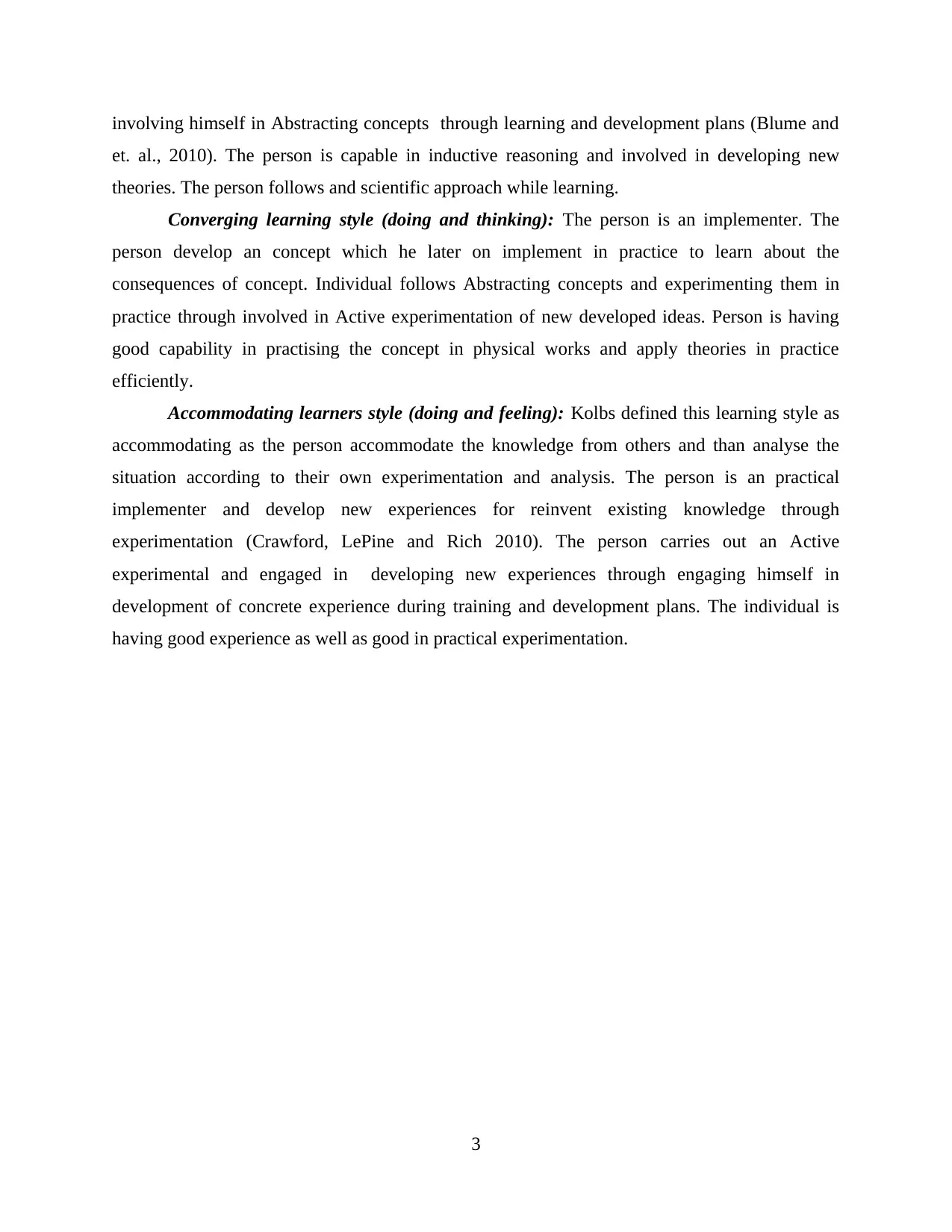
involving himself in Abstracting concepts through learning and development plans (Blume and
et. al., 2010). The person is capable in inductive reasoning and involved in developing new
theories. The person follows and scientific approach while learning.
Converging learning style (doing and thinking): The person is an implementer. The
person develop an concept which he later on implement in practice to learn about the
consequences of concept. Individual follows Abstracting concepts and experimenting them in
practice through involved in Active experimentation of new developed ideas. Person is having
good capability in practising the concept in physical works and apply theories in practice
efficiently.
Accommodating learners style (doing and feeling): Kolbs defined this learning style as
accommodating as the person accommodate the knowledge from others and than analyse the
situation according to their own experimentation and analysis. The person is an practical
implementer and develop new experiences for reinvent existing knowledge through
experimentation (Crawford, LePine and Rich 2010). The person carries out an Active
experimental and engaged in developing new experiences through engaging himself in
development of concrete experience during training and development plans. The individual is
having good experience as well as good in practical experimentation.
3
et. al., 2010). The person is capable in inductive reasoning and involved in developing new
theories. The person follows and scientific approach while learning.
Converging learning style (doing and thinking): The person is an implementer. The
person develop an concept which he later on implement in practice to learn about the
consequences of concept. Individual follows Abstracting concepts and experimenting them in
practice through involved in Active experimentation of new developed ideas. Person is having
good capability in practising the concept in physical works and apply theories in practice
efficiently.
Accommodating learners style (doing and feeling): Kolbs defined this learning style as
accommodating as the person accommodate the knowledge from others and than analyse the
situation according to their own experimentation and analysis. The person is an practical
implementer and develop new experiences for reinvent existing knowledge through
experimentation (Crawford, LePine and Rich 2010). The person carries out an Active
experimental and engaged in developing new experiences through engaging himself in
development of concrete experience during training and development plans. The individual is
having good experience as well as good in practical experimentation.
3
⊘ This is a preview!⊘
Do you want full access?
Subscribe today to unlock all pages.

Trusted by 1+ million students worldwide
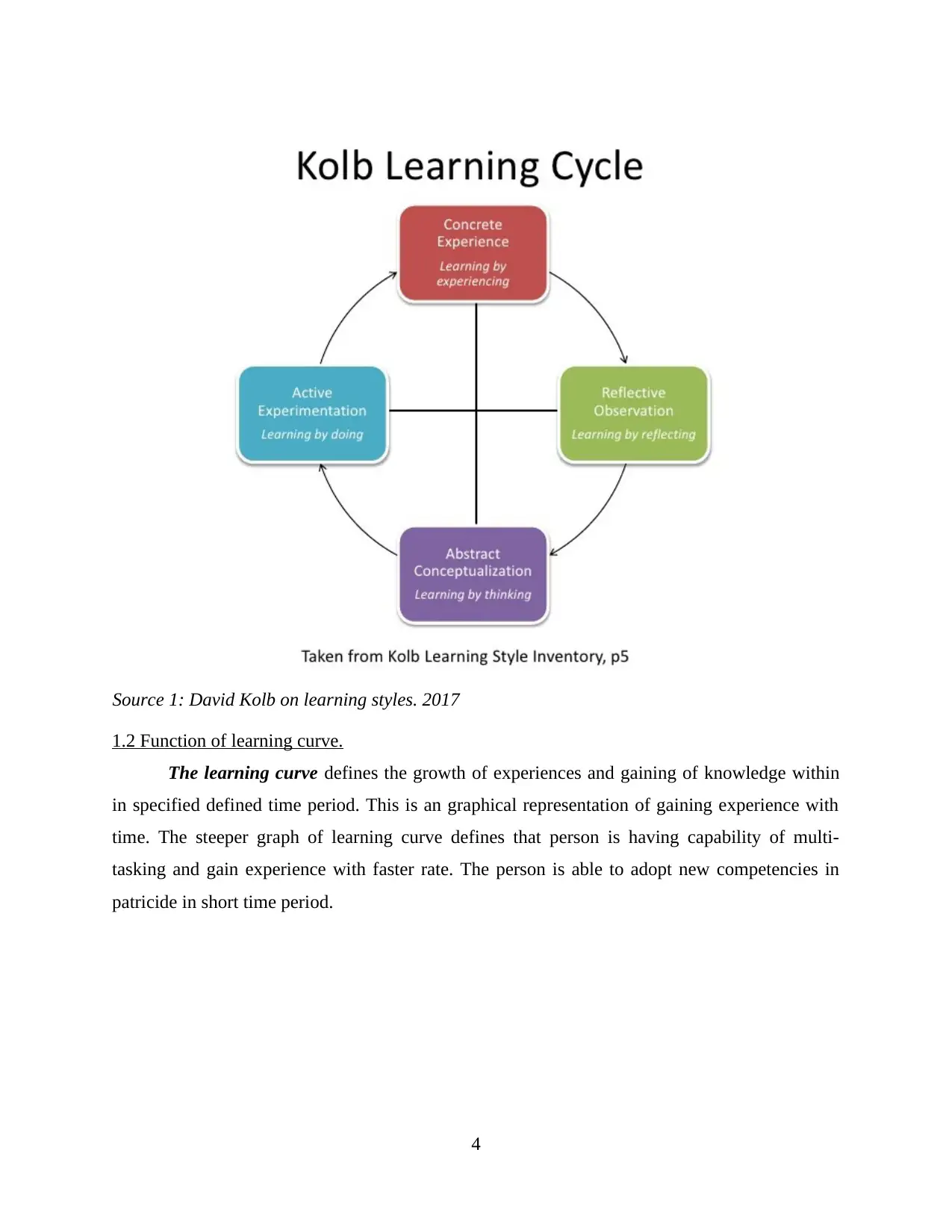
1.2 Function of learning curve.
The learning curve defines the growth of experiences and gaining of knowledge within
in specified defined time period. This is an graphical representation of gaining experience with
time. The steeper graph of learning curve defines that person is having capability of multi-
tasking and gain experience with faster rate. The person is able to adopt new competencies in
patricide in short time period.
4
Source 1: David Kolb on learning styles. 2017
The learning curve defines the growth of experiences and gaining of knowledge within
in specified defined time period. This is an graphical representation of gaining experience with
time. The steeper graph of learning curve defines that person is having capability of multi-
tasking and gain experience with faster rate. The person is able to adopt new competencies in
patricide in short time period.
4
Source 1: David Kolb on learning styles. 2017
Paraphrase This Document
Need a fresh take? Get an instant paraphrase of this document with our AI Paraphraser

Implementation of learnings in practice is utmost responsibility of an employer so that
they can contribute in success of organisation efficiently. The functions of implementation of
learnings and skills in practice are as follow:
Add value: The experienced person adds value in the profitability of the firm through
gaining newer capabilities in behaviour (Demil and Lecocq, 2010). The employee develop new
capabilities in actions which enhance the performance of workforce which helps in delivering
good quality services to the customers.
Proper utilization of fund: Experimenting the learnings in practice by employee results
in effective utilisation of funding that are invested in the training and development programme
by the employer.
Face and overcome challenges: The employee of sun count company is able to face new
challenges and make an effective decisions independently after participation in development
programme of firm. This helps in increasing efficiency of employees and contributes in efficient
services to the old age person of sun count homes.
5
Source 2: Let’s Not Forget the Forgetting Curve. 2017
they can contribute in success of organisation efficiently. The functions of implementation of
learnings and skills in practice are as follow:
Add value: The experienced person adds value in the profitability of the firm through
gaining newer capabilities in behaviour (Demil and Lecocq, 2010). The employee develop new
capabilities in actions which enhance the performance of workforce which helps in delivering
good quality services to the customers.
Proper utilization of fund: Experimenting the learnings in practice by employee results
in effective utilisation of funding that are invested in the training and development programme
by the employer.
Face and overcome challenges: The employee of sun count company is able to face new
challenges and make an effective decisions independently after participation in development
programme of firm. This helps in increasing efficiency of employees and contributes in efficient
services to the old age person of sun count homes.
5
Source 2: Let’s Not Forget the Forgetting Curve. 2017
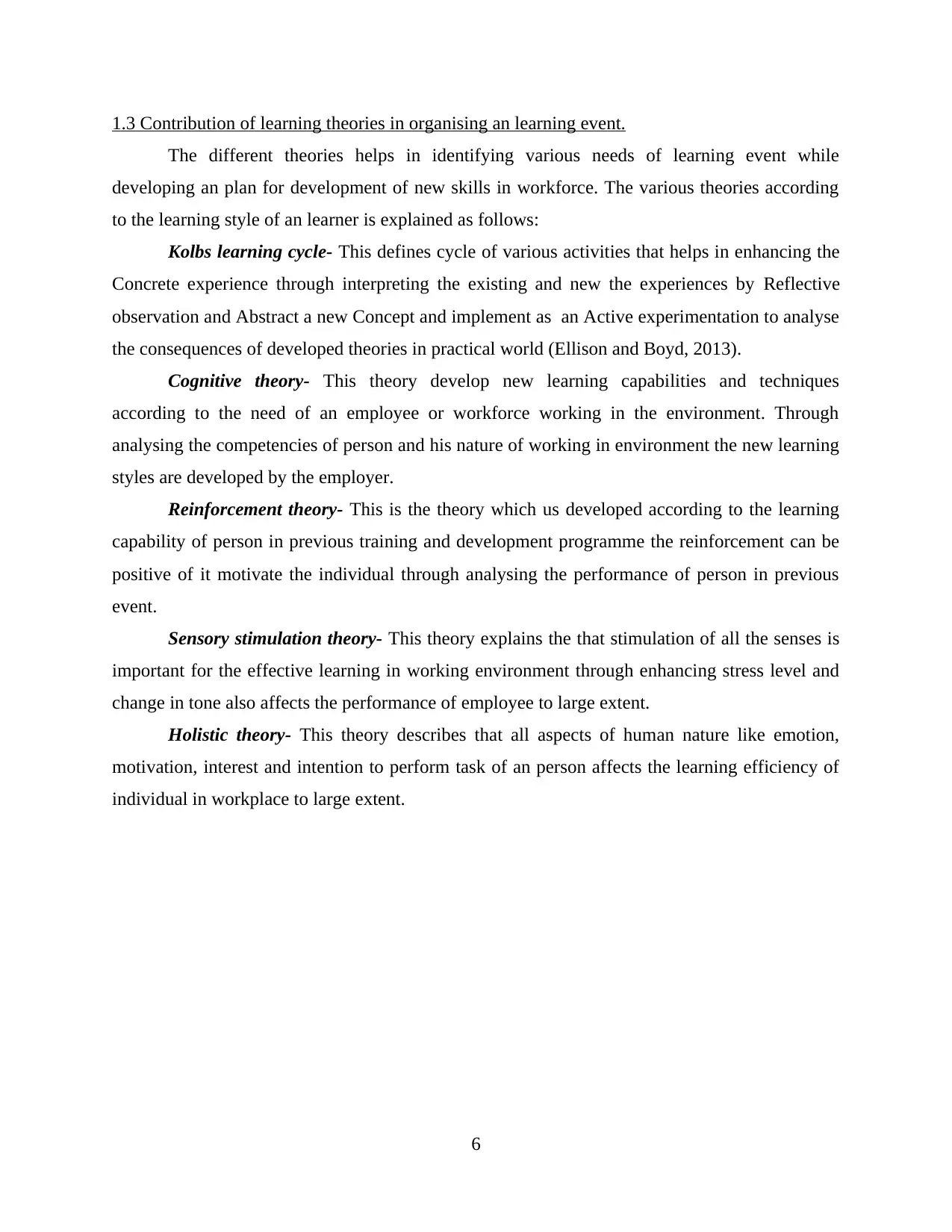
1.3 Contribution of learning theories in organising an learning event.
The different theories helps in identifying various needs of learning event while
developing an plan for development of new skills in workforce. The various theories according
to the learning style of an learner is explained as follows:
Kolbs learning cycle- This defines cycle of various activities that helps in enhancing the
Concrete experience through interpreting the existing and new the experiences by Reflective
observation and Abstract a new Concept and implement as an Active experimentation to analyse
the consequences of developed theories in practical world (Ellison and Boyd, 2013).
Cognitive theory- This theory develop new learning capabilities and techniques
according to the need of an employee or workforce working in the environment. Through
analysing the competencies of person and his nature of working in environment the new learning
styles are developed by the employer.
Reinforcement theory- This is the theory which us developed according to the learning
capability of person in previous training and development programme the reinforcement can be
positive of it motivate the individual through analysing the performance of person in previous
event.
Sensory stimulation theory- This theory explains the that stimulation of all the senses is
important for the effective learning in working environment through enhancing stress level and
change in tone also affects the performance of employee to large extent.
Holistic theory- This theory describes that all aspects of human nature like emotion,
motivation, interest and intention to perform task of an person affects the learning efficiency of
individual in workplace to large extent.
6
The different theories helps in identifying various needs of learning event while
developing an plan for development of new skills in workforce. The various theories according
to the learning style of an learner is explained as follows:
Kolbs learning cycle- This defines cycle of various activities that helps in enhancing the
Concrete experience through interpreting the existing and new the experiences by Reflective
observation and Abstract a new Concept and implement as an Active experimentation to analyse
the consequences of developed theories in practical world (Ellison and Boyd, 2013).
Cognitive theory- This theory develop new learning capabilities and techniques
according to the need of an employee or workforce working in the environment. Through
analysing the competencies of person and his nature of working in environment the new learning
styles are developed by the employer.
Reinforcement theory- This is the theory which us developed according to the learning
capability of person in previous training and development programme the reinforcement can be
positive of it motivate the individual through analysing the performance of person in previous
event.
Sensory stimulation theory- This theory explains the that stimulation of all the senses is
important for the effective learning in working environment through enhancing stress level and
change in tone also affects the performance of employee to large extent.
Holistic theory- This theory describes that all aspects of human nature like emotion,
motivation, interest and intention to perform task of an person affects the learning efficiency of
individual in workplace to large extent.
6
⊘ This is a preview!⊘
Do you want full access?
Subscribe today to unlock all pages.

Trusted by 1+ million students worldwide
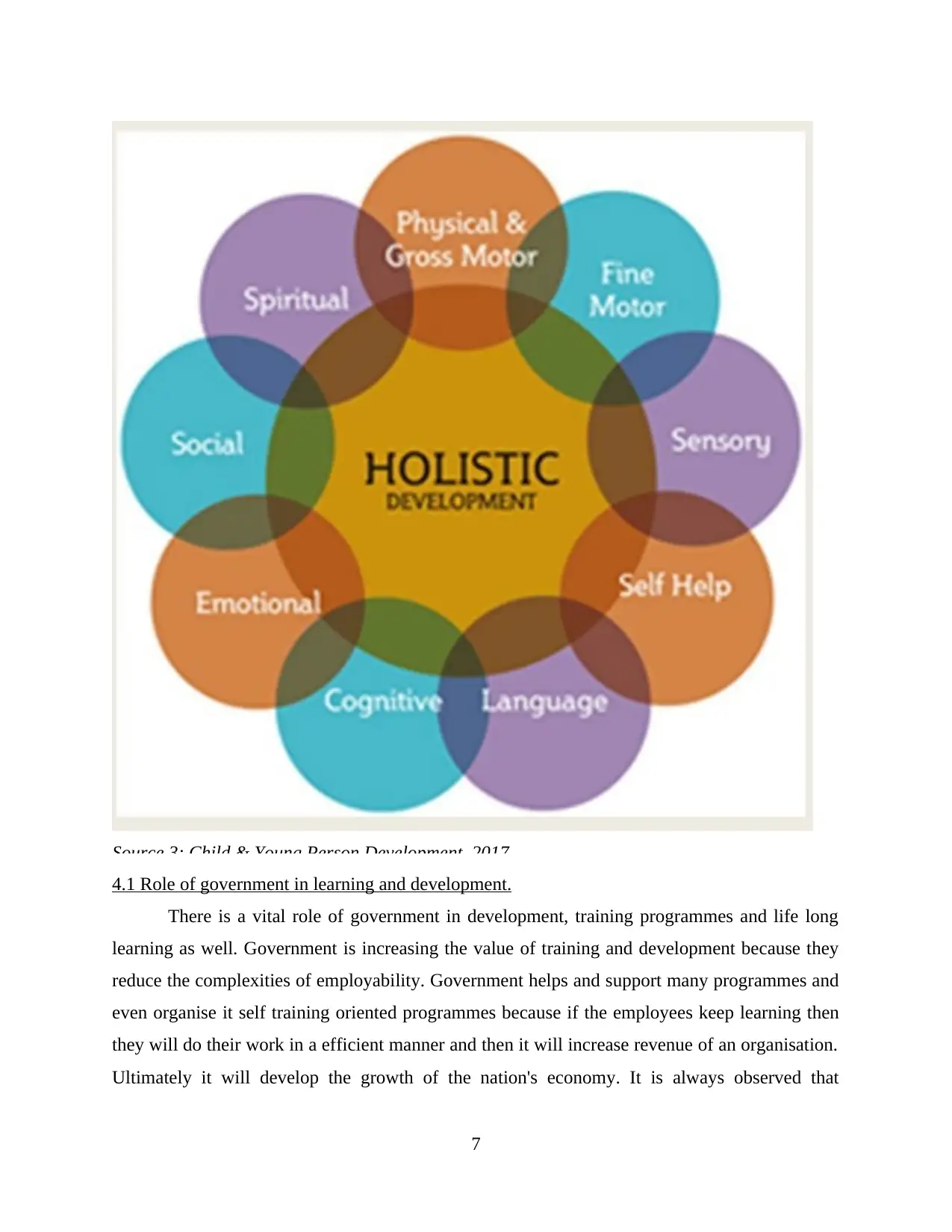
Source 3: Child & Young Person Development. 2017
4.1 Role of government in learning and development.
There is a vital role of government in development, training programmes and life long
learning as well. Government is increasing the value of training and development because they
reduce the complexities of employability. Government helps and support many programmes and
even organise it self training oriented programmes because if the employees keep learning then
they will do their work in a efficient manner and then it will increase revenue of an organisation.
Ultimately it will develop the growth of the nation's economy. It is always observed that
7
4.1 Role of government in learning and development.
There is a vital role of government in development, training programmes and life long
learning as well. Government is increasing the value of training and development because they
reduce the complexities of employability. Government helps and support many programmes and
even organise it self training oriented programmes because if the employees keep learning then
they will do their work in a efficient manner and then it will increase revenue of an organisation.
Ultimately it will develop the growth of the nation's economy. It is always observed that
7
Paraphrase This Document
Need a fresh take? Get an instant paraphrase of this document with our AI Paraphraser
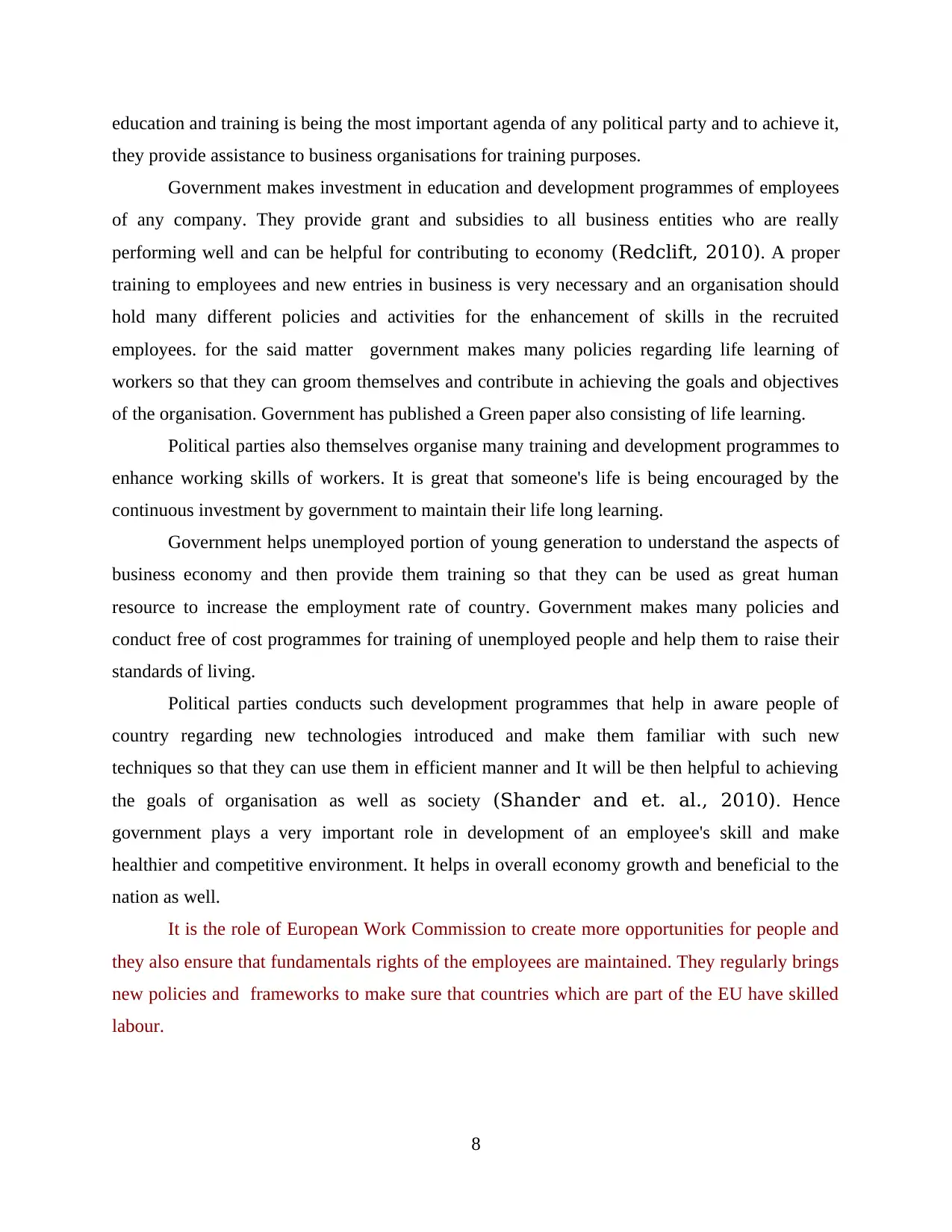
education and training is being the most important agenda of any political party and to achieve it,
they provide assistance to business organisations for training purposes.
Government makes investment in education and development programmes of employees
of any company. They provide grant and subsidies to all business entities who are really
performing well and can be helpful for contributing to economy (Redclift, 2010). A proper
training to employees and new entries in business is very necessary and an organisation should
hold many different policies and activities for the enhancement of skills in the recruited
employees. for the said matter government makes many policies regarding life learning of
workers so that they can groom themselves and contribute in achieving the goals and objectives
of the organisation. Government has published a Green paper also consisting of life learning.
Political parties also themselves organise many training and development programmes to
enhance working skills of workers. It is great that someone's life is being encouraged by the
continuous investment by government to maintain their life long learning.
Government helps unemployed portion of young generation to understand the aspects of
business economy and then provide them training so that they can be used as great human
resource to increase the employment rate of country. Government makes many policies and
conduct free of cost programmes for training of unemployed people and help them to raise their
standards of living.
Political parties conducts such development programmes that help in aware people of
country regarding new technologies introduced and make them familiar with such new
techniques so that they can use them in efficient manner and It will be then helpful to achieving
the goals of organisation as well as society (Shander and et. al., 2010). Hence
government plays a very important role in development of an employee's skill and make
healthier and competitive environment. It helps in overall economy growth and beneficial to the
nation as well.
It is the role of European Work Commission to create more opportunities for people and
they also ensure that fundamentals rights of the employees are maintained. They regularly brings
new policies and frameworks to make sure that countries which are part of the EU have skilled
labour.
8
they provide assistance to business organisations for training purposes.
Government makes investment in education and development programmes of employees
of any company. They provide grant and subsidies to all business entities who are really
performing well and can be helpful for contributing to economy (Redclift, 2010). A proper
training to employees and new entries in business is very necessary and an organisation should
hold many different policies and activities for the enhancement of skills in the recruited
employees. for the said matter government makes many policies regarding life learning of
workers so that they can groom themselves and contribute in achieving the goals and objectives
of the organisation. Government has published a Green paper also consisting of life learning.
Political parties also themselves organise many training and development programmes to
enhance working skills of workers. It is great that someone's life is being encouraged by the
continuous investment by government to maintain their life long learning.
Government helps unemployed portion of young generation to understand the aspects of
business economy and then provide them training so that they can be used as great human
resource to increase the employment rate of country. Government makes many policies and
conduct free of cost programmes for training of unemployed people and help them to raise their
standards of living.
Political parties conducts such development programmes that help in aware people of
country regarding new technologies introduced and make them familiar with such new
techniques so that they can use them in efficient manner and It will be then helpful to achieving
the goals of organisation as well as society (Shander and et. al., 2010). Hence
government plays a very important role in development of an employee's skill and make
healthier and competitive environment. It helps in overall economy growth and beneficial to the
nation as well.
It is the role of European Work Commission to create more opportunities for people and
they also ensure that fundamentals rights of the employees are maintained. They regularly brings
new policies and frameworks to make sure that countries which are part of the EU have skilled
labour.
8
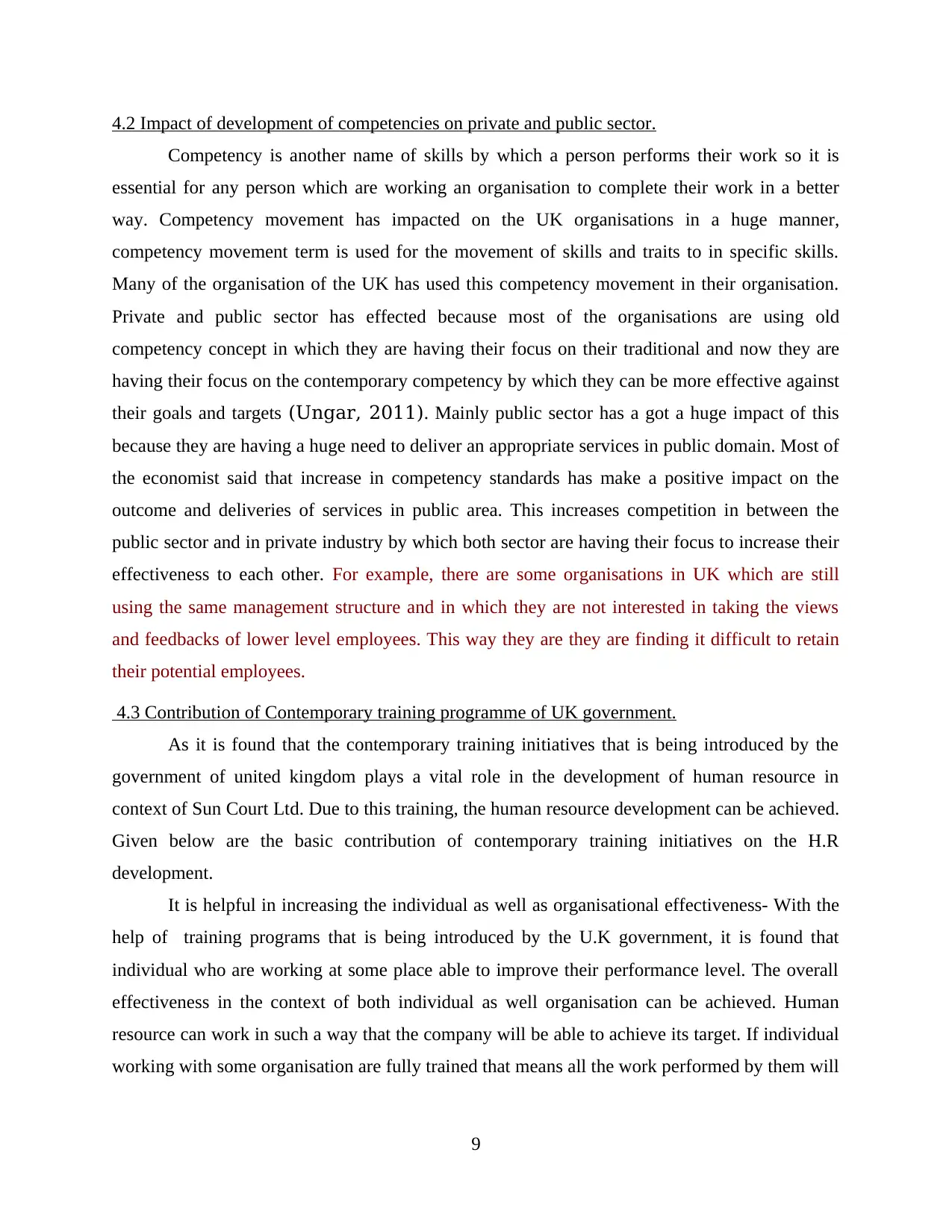
4.2 Impact of development of competencies on private and public sector.
Competency is another name of skills by which a person performs their work so it is
essential for any person which are working an organisation to complete their work in a better
way. Competency movement has impacted on the UK organisations in a huge manner,
competency movement term is used for the movement of skills and traits to in specific skills.
Many of the organisation of the UK has used this competency movement in their organisation.
Private and public sector has effected because most of the organisations are using old
competency concept in which they are having their focus on their traditional and now they are
having their focus on the contemporary competency by which they can be more effective against
their goals and targets (Ungar, 2011). Mainly public sector has a got a huge impact of this
because they are having a huge need to deliver an appropriate services in public domain. Most of
the economist said that increase in competency standards has make a positive impact on the
outcome and deliveries of services in public area. This increases competition in between the
public sector and in private industry by which both sector are having their focus to increase their
effectiveness to each other. For example, there are some organisations in UK which are still
using the same management structure and in which they are not interested in taking the views
and feedbacks of lower level employees. This way they are they are finding it difficult to retain
their potential employees.
4.3 Contribution of Contemporary training programme of UK government.
As it is found that the contemporary training initiatives that is being introduced by the
government of united kingdom plays a vital role in the development of human resource in
context of Sun Court Ltd. Due to this training, the human resource development can be achieved.
Given below are the basic contribution of contemporary training initiatives on the H.R
development.
It is helpful in increasing the individual as well as organisational effectiveness- With the
help of training programs that is being introduced by the U.K government, it is found that
individual who are working at some place able to improve their performance level. The overall
effectiveness in the context of both individual as well organisation can be achieved. Human
resource can work in such a way that the company will be able to achieve its target. If individual
working with some organisation are fully trained that means all the work performed by them will
9
Competency is another name of skills by which a person performs their work so it is
essential for any person which are working an organisation to complete their work in a better
way. Competency movement has impacted on the UK organisations in a huge manner,
competency movement term is used for the movement of skills and traits to in specific skills.
Many of the organisation of the UK has used this competency movement in their organisation.
Private and public sector has effected because most of the organisations are using old
competency concept in which they are having their focus on their traditional and now they are
having their focus on the contemporary competency by which they can be more effective against
their goals and targets (Ungar, 2011). Mainly public sector has a got a huge impact of this
because they are having a huge need to deliver an appropriate services in public domain. Most of
the economist said that increase in competency standards has make a positive impact on the
outcome and deliveries of services in public area. This increases competition in between the
public sector and in private industry by which both sector are having their focus to increase their
effectiveness to each other. For example, there are some organisations in UK which are still
using the same management structure and in which they are not interested in taking the views
and feedbacks of lower level employees. This way they are they are finding it difficult to retain
their potential employees.
4.3 Contribution of Contemporary training programme of UK government.
As it is found that the contemporary training initiatives that is being introduced by the
government of united kingdom plays a vital role in the development of human resource in
context of Sun Court Ltd. Due to this training, the human resource development can be achieved.
Given below are the basic contribution of contemporary training initiatives on the H.R
development.
It is helpful in increasing the individual as well as organisational effectiveness- With the
help of training programs that is being introduced by the U.K government, it is found that
individual who are working at some place able to improve their performance level. The overall
effectiveness in the context of both individual as well organisation can be achieved. Human
resource can work in such a way that the company will be able to achieve its target. If individual
working with some organisation are fully trained that means all the work performed by them will
9
⊘ This is a preview!⊘
Do you want full access?
Subscribe today to unlock all pages.

Trusted by 1+ million students worldwide
1 out of 21
Related Documents
Your All-in-One AI-Powered Toolkit for Academic Success.
+13062052269
info@desklib.com
Available 24*7 on WhatsApp / Email
![[object Object]](/_next/static/media/star-bottom.7253800d.svg)
Unlock your academic potential
Copyright © 2020–2025 A2Z Services. All Rights Reserved. Developed and managed by ZUCOL.




